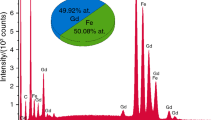Abstract
Synthetic iron-manganese glycerates with compositions corresponding to different molar ratios of Fe: Mn, contain large amounts of H2O (up to 22%). Heating in air at ≈270°C produces a hydrated, disordered Mn-ferrite structure (jacobsite), as shown by XRD and IR spectroscopy. At this temperature no alkoxide groups are detected. TG curves show 45.6% to ≈54% weight losses at 290°C, with a sharp loss from 270° to 290°C for all samples, attributed mostly to the Curie transition of MnFe2O4. Further heating of each sample at ≈670°C results in a well-crystallized hematite and variable amounts of bixbyite. At this stage no H2O is left. Further calcination at ≈1050°C gives qualitatively the same products as at 670°C. Colour changes occur during the heating process. In admixtures of goethite with MnCO3 or pyrolusite the main difference from the counterpart alkoxide is shown after heating at 270°C, when the Fe−Mn mineral mixture produces mostly protohematite (disordered hematite) instead of disordered jacobsite resulting from the alkoxides.
Zusammenfassung
Synthetische Eisen-Manganglycerate mit Zusammensetzungen mit unterschiedlichen Fe:Mn-Verhältnissen enthalten eine große Menge Wasser (bis 22%). Wie Röntgendiffraktion und IR-Spektroskopie zeigen, entsteht beim Erhitzen an Luft bei etwa 270°C eine hydratierte, fehlgeordnete Mn-Ferrit-Struktur (Jacobsit). Bei dieser Temperatur werden keine Alkoxidgruppen festgestellt. Die TG-Kurven zeigen einen 45.6–54%-igen Gewichtsverlust bei 290°C, mit einem scharfen Verlustpeak zwischen 270° und 290°C für alle Proben, meist charakterisiert durch eine Curie-Umwandlung von MnFe2O4. Ein weiteres Erhitzen aller Proben ergibt bei etwa 670°C gutkristallisiertes Hämatit und verschiedene Mengen Bixbyit. An dieser Stelle wird kein Wasser zurückgelassen. Ein weiteres Kalzinieren bei etwa 1050°C liefert qualitativ die gleichen Produkte wie bei 670°C. Während des Erhitzungsvorganges verändern sich die Farben. In Gemischen von Goethit mit MnCO3 oder Pyrolusit zeigt sich der Hauptunterschied nach Erhitzen bei 270°C, wenn das Fe−Mn-Mineralgemisch anstelle des fehlgeordneten Jacobsit hauptsächlich Protohämatit (fehlgeordnetes Hämatit) ergibt.
Similar content being viewed by others
References
E. W. Radoslovich, M. Raupach, P. G. Slade and R. M. Taylor, Aust. J. Chem., 23 (1970) 1963.
E. Mendelovici, A. Sagarzazu and R. Villalba, Thermochim. Acta, 107 (1986) 75.
E. Mendelovici, R. Villalba and A. Sagarzazu, J. Mater. Sci. Lett. 9 (1990) 28.
M. A. Denecke, W. GunBer, G. Buxbaum and P. Kuske, Mat. Res. Bull., 27 (1992) 507.
Sh. Yariv and E. Mendelovici, Applied Spectroscopy, 33 (1979) 410.
J. H. Boy and G. P. Wirtz, in L. C. Dufour et al. (eds.), Surfaces and Interfaces of Ceramic Materials, Kluwer Academic Publishers, 1989, p. 691.
Author information
Authors and Affiliations
Rights and permissions
About this article
Cite this article
Mendelovici, E., Sagarzazu, A. & Villalba, R. Comparative thermal transformations of synthetic Fe−Mn glycerate (alkoxides). Journal of Thermal Analysis 40, 1115–1122 (1993). https://doi.org/10.1007/BF02546872
Published:
Issue Date:
DOI: https://doi.org/10.1007/BF02546872




